Travel
The Beginner’s Guide to Adventure Travel in Costa Rica
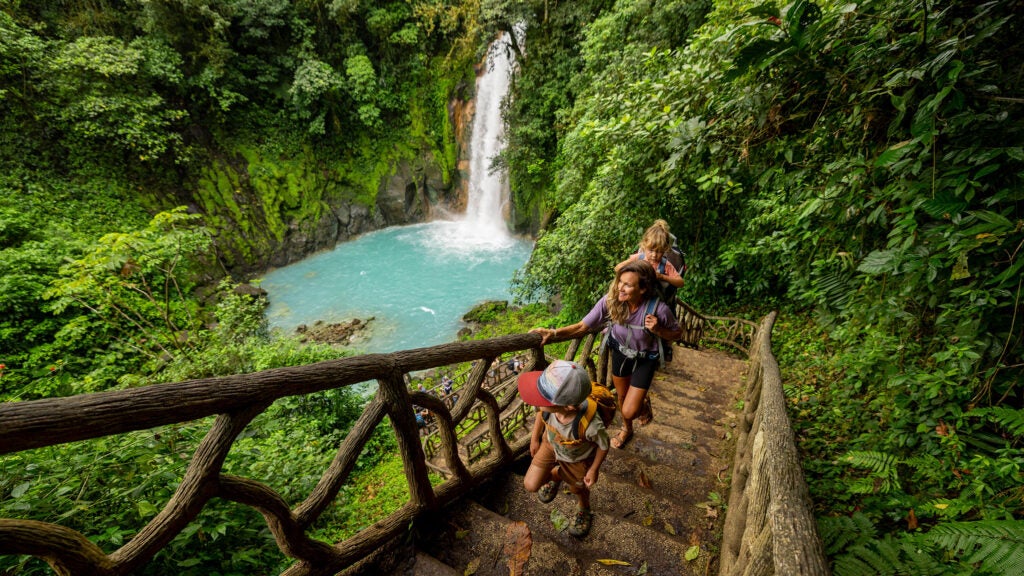
One of the most biodiverse places on the planet, Costa Rica is a carefully preserved paradise for adventure travelers. The country’s government has protected one quarter of its land by designating parks, refuges, and reserves, and safeguarded approximately 30 percent of its marine area, too.
I first started traveling to Costa Rica nearly two decades ago, drawn to its then sleepy, surf-swept Pacific coast. As more people started to discover the pura vida vibes of laid-back beach towns like Malpais and Nosara, I ventured further inland and visited the wildlife-packed natural parks and cloud forests in the north. More recently, I scoped out the Caribbean coast, home to stellar waves, snorkel spots, and hiking trails, and a totally distinct culture—food, music, architecture—that made me feel like I was rediscovering a country I thought I knew.
On my latest trip last year, I hiked the country’s 174-mile, coast-to-coast Camino de Costa Rica trail with outfitter UrriTrek (from $565). This cross-country trail is the ultimate showcase for Costa Rica’s cultural and natural diversity, crossing four provinces and seven microclimates. (If you don’t have time to complete the entire 16-day hike, you can piece together an itinerary that delivers just as much variety in a shorter time frame.)
Bottom line: I don’t think I’ll ever tire of traveling to Costa Rica. From kayaking freshwater canals and surfing barrel waves to zip lining through clouded forests and scuba diving colorful reefs, Costa Rica offers the best adventure travel options. Here’s a cheat sheet to experiencing the country’s highlights, including six must-know tips from a local expert if you’ve never been before.
If you buy through our links, we may earn an affiliate commission. This supports our mission to get more people active and outside. Learn more.
Map of Costa Rica: Regions and National Parks to Visit
This interactive map of Costa Rica highlights the country’s diverse regions, and pinpoints each national park I mention below—all musts for first-time visitors. (Map: Erin McKnight)
Costa Rica Travel: A Word on Getting Around
Newbies should know that most of the country’s coolest spots require a car to get there. You can rent one at airports for a DIY road trip, or hire a driver to take you from region to region. Below, I share both flight and car options to reach each of destination. Plus, how renting the right rig and interpreting weather forecasts can dramatically impact your experience. Now, to the good stuff.
Costa Rica’s Pacific Coast
Surf swept coastline, laid back beach towns, and intensely biodiverse protected areas—both on land and at sea—make this one of the most popular areas for adventure.
Where to Go in the Nicoya Peninsula

Nosara
One of five official Blue Zones, geographically designated areas people statistically live longer, the Nicoya Peninsula offers an endless choice of dreamy beach towns including Santa Teresa, Malpais, and Manzanillo. But, Nosara stands out for its long, wide, golden sand beach, Playa Guiones, which has perfect waves for longboarding. You’ll find countless surf schools, including Surf Simply ($8,300 per week including room and meals), Chorotegas Surf School (lessons from $125; board rentals from $25 for a half-day) and Ten Toes Surf (lessons from $120; week-long retreats from $5,642), where you can finesse your pop up or have a guide take you wave hunting up the coast. And there are plenty of delicious restaurants to refuel you, like Howler’s Beach Lounge (its fish tacos are a must).
✈️ 🚗 How to Get There: Guanacaste’s Daniel Oduber Quirós International Airport, also known as Liberia International Airport (LIR) is roughly 2.5 hours by car. Juan Santamaría International Airport (SJO) in San José is a five to six hour drive.
🌴 🛏️ Where to Stay: Family-friendly Gilded Iguana Surf Hotel is a five-minute walk to Playa Guiones and has its own surf club and school and offers mountain bike rentals and tours (from $168 per night).
Where to Go in the Osa Peninsula

Corcovado National Park
Located in the southernmost region on the Pacific coast, Corcovado National Park packs 2.5 percent of the world’s biodiversity into .001 percent of its surface area. The country’s largest park covers more than 30 percent of the Osa Peninsula and protects mammals like the two and three-toed sloths, cougar, and giant anteaters, birds like the endangered Baird’s tapir, several types of hummingbirds, and one of the largest populations of scarlet macaws, and some 220 species of butterflies. Trails range from the mellow .8-mile out-and-back Quebrada San Pedro that leads to a view of a waterfall to the day-long, 6.3-mile out-and-back La Leona Madrigal, a bird watcher’s dream with epic sea views.
✈️ 🚗 How to Get There: Sansa Airlines has daily 50-minute flights from San José to Puerto Jiménez airstrip (PJM). The drive from San José is around seven hours.
🌴 🛏️ Where to Stay: Founded in 1993, Lapas Rios is often called Costa Rica’s original eco-lodge. Rooms are nestled amidst the treetops of a 1,000-acre private reserve of Central America’s last remaining tropical lowland rainforest that skirts the park boundary (from $823 per night).
Book Airbnbs in the Osa Peninsula
Where to Go in the Central Pacific
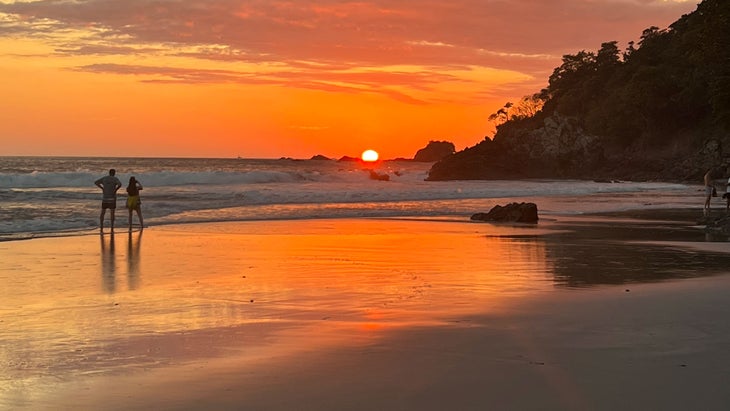
Manuel Antonio National Park
This seven-square-mile protected area combines beautiful beaches, rainforests, and wildlife. The resort town of the same name has all the amenities you’d want from an access point to such pristine nature. Wide, golden beaches including Escondido Beach, Manuel Antonio Beach, and Espadilla Sur can be reached via the main, 1.3-mile flat trail. The government recently capped daily visitors at 1,200 people and you must pre-book an entry ticket. The park is closed Tuesdays.
✈️ 🚗 How to Get There: From San José it’s a three-hour drive or a 20-minute flight on Sansa to the gateway town of Quepos (XQP).
🌴 🛏️ Where to Stay: Splurge on a stay at Arenas del Mar, a sustainable, community-minded resort set on an 11-acre, trail-laced, private nature reserve. After a ten-minute walk from the property, a short trail unfurls to the north end of the beach, and the resort’s team of naturalists took me on nature walks to point out sloths and fiery-billed aracari (from $610 per night).
Marino Ballena National Park
One of the country’s newest national parks has a distinctive whale’s tail shape and is committed to conserving the marine systems within its boundaries. Twice a year (mid-July to October and December to March) humpback whales migrate to these waters. Book a whale-watching tour with Bahia Aventuras (from $78). The local outfitter also offers snorkeling tours to Isla de Caño, which lies just outside of the protected area but promises sightings of dolphins, turtles, and colorful fish. Bodhi Surf + Yoga hosts camps (one week from $1,795) and one-off surf lessons (from $65) at beach breaks in the park. The park has four entrance points, but head to Uvita—the main gateway to Whale Tail Beach where boat tours depart.
✈️ 🚗 How to Get There: From San José it’s around a four-hour drive or connect via a 20-minute flight on Sansa to Quepos, then drive one hour.
🌴 🛏️ Where to Stay: Perched high atop a steep hill, Kurà has unparalleled views of Uvita town and the national park from its eight suites, open-air restaurant, and infinity pool (from $788 per night). And the more affordable Oxygen Jungle Villas in Uvita has just 12 rooms, each with terraces from which guests can spot hummingbirds and toucans (from $155 per night).
Costa Rica’s Caribbean Coast

The less trodden east coast offers all of the natural beauty—wildlife-filled rainforests, virgin beaches—of the west, but has fewer crowds and a distinct Afro-Caribbean culture. Expect to hear Patois spoken alongside Spanish, dance to Calypso music, and dine on Jamaican-influenced cuisine like saltfish fritters and rondon, a rich coconut stew.
Where to Go in the Northern Caribbean
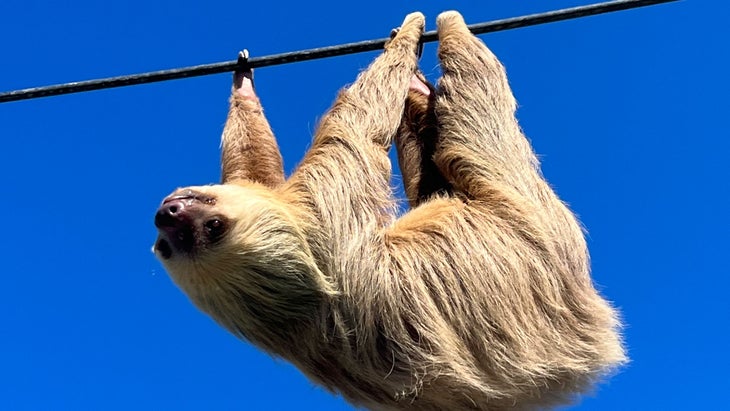
Tortuguero National Park
This nearly 50,000-acre patchwork of canals, lagoons, dense jungle, thick mangrove forest, and beaches on the northern Caribbean Coast often draws comparisons to the Amazon. The name is a nod to the thousands of turtles that nest on its shores, mainly from July through October. In addition to leatherback, loggerhead, hawksbill, and green sea turtles, you can see around 400 species of birds, including toucans and spoonbills, 60 some species of mammals, and over 100 reptiles. Within hours of a recent visit, I ticked off sightings of capuchin monkeys, a sloth, red dart frogs, howler monkeys, and the emerald basilisk. A night boat tour along the canals revealed the glowing eyes of crocodiles, a coiled boa in a tree, and my eagle-eyed guide spotted a common potoo camouflaged in a cluster of broken branches.
✈️ 🚗 How to Get There: The park can only be accessed by boat or plane. From San José, you can drive two hours to the La Pavona Dock and catch a two-hour scenic boat transfer. Sansa has a daily 40-minute flight to Tortuguero Airport (TTQ). Most lodges in the parks can arrange van and boat transfers from San José.
🌴 🛏️ Where to Stay: Lirio Lodge is a collection of 11 humble, off-grid bungalows immersed in jungle and perched in front of the Madre de Dios lagoon. Guests have free use of kayaks and canoes and can join day and evening boat tours guided by wildlife experts (minimum two-night stay from $700).
Where to Go in the Southern Caribbean

Note: These three destinations below are accessible day trips from Limón, so you can pack each hot spot into a span of a few days—or better yet, take more time and relish the diverse nature of each. Our tips below on how to get there and where to stay apply across the board here.
Puerto Viejo de Talamanca
In fall, expert surfers flock to this lively beach town to test their mettle riding Salsa Brava, arguably Costa Rica’s biggest barreling wave. The black sands of Playa Negra are ideal for lounging beneath palm fronds and an excursion to the nearby Jaguar Rescue Center, which rehabilitates and rewilds the cats, is a must. You can get a taste of the region’s signature Afro-Caribbean flavors and sign up for Afro-Latin dance classes at locally loved Salsa Brava Restaurant & Bar. The town is also a jumping off point for Cahuita National Park and Gandoca-Manzanillo National WIldlife Refuge.
Cahuita National Park
Set aside one day to explore the coastal wildlife trails that reveal sloth, monkeys, keel-billed toucan, and paca, a rodent that resembles a big guinea pig. The other should be devoted to chilling on the unspoiled beaches or snorkeling and diving the largest system of reefs in Costa Rica. In autumn the waters are calm and clear, making it easy to view stingrays, reef sharks, and 35 types of coral. Surf the Jungle guides boat trips to snorkel the reef of Cahuita National Park ($90).
Gandoca-Manzanillo National Wildlife Refuge
Stretching south nearly to the border of Panama, this collection of unique habitats includes a six-mile swath of golden sand, two swamps, a vibrant coral reef, and 740 acres of trail-laced rainforest. The reef teems with brain coral, Venus sea fans, neon anemones, electric blue parrot fish, and along the coastline you’ll find rare mangrove oyster beds. On land, you may spot endangered ocelot, the elusive harpy eagle, and from March to May four species of turtles come to nest here.
✈️ 🚗 How to Get There: From San José, you can drive five and a half hours, or Sansa offers multiple daily 35-minute flights to Limón International Airport (LIO).
🌴 🛏️ Where to Stay: Hotel Aguas Claras has 15 boho-chic rooms nestled on a forest-fringed beach in Puerto Viejo. I’m a fan of the complimentary bikes and snorkel gear, and applaud the hotel’s commitment to hiring employees and sourcing ingredients locally. The national park is just 25 minutes away and the wildlife refuge, ten minutes; the hotel can arrange tours of both. (Rooms from $365 per night.)
Costa Rica’s Northern Region
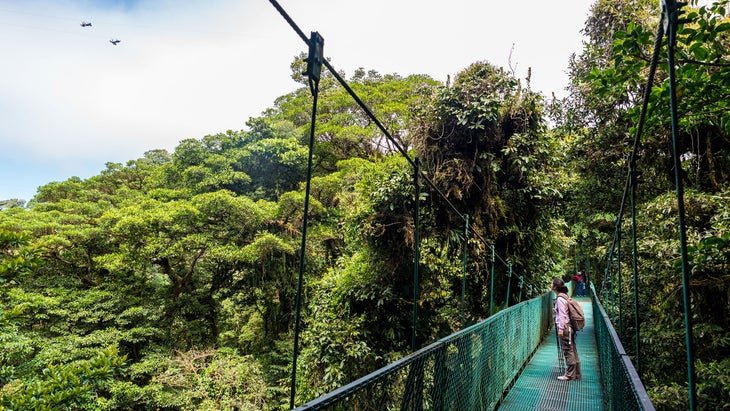
You could spend a lifetime park hopping in the north. First timers won’t want to skip Costa Rica’s crown jewels: Monteverde Cloud Forest Biological Reserve and Arenal Volcano. Miravalles Volcano National Park, Tenorio Volcano Park, and waterfall mecca Juan Castro Blanco National Park are less known but equally spectacular.
Monteverde Cloud Forest Biological Reserve
The cloud forests of Monte Verde, a more than 35,000-acre reserve in the Cordillera de Tilarán mountain range, contain approximately 50 percent of the country’s flora and fauna, including over 420 types of orchids, 200 species of ferns, rare birds like the three-wattled bellbird and iconic resplendent quetzal, and charismatic mammals like the sloth. You can get a bird’s eye view of the wildlife from walkways suspended in the canopies or on a zip line tour. Monteverde Expeditions leads night walks in nearby Monteverde Wildlife Refuge where you can observe nocturnal animals like ocelot, sloth, and armadillos (tickets from $25).
✈️ 🚗 How to Get There: It’s about a 2.5-hour drive from either San José or Guanacaste airports.
🌴 🛏️ Where to Stay: A hanging bridge connects Senda Monteverde Hotel (from $265 per night) to Aguti Wildlife Reserve and guests get free admission. The reserve is minutes away and the hotel’s in-house naturalists take guests on tours of the adjacent expanse.
Arenal Volcano National Park
The park’s namesake stratovolcano soars 5,357 feet towards the clouds and is one of the northern region’s most popular attractions. But there’s plenty else to see and do in the 30,000-acre protected area including zip lining, river rafting, horseback riding, and hiking. The Heliconias, Coladas, Tucanes, and Los Miradores trails provide views of flora and fauna as well as the remains of volcanic lava tracts. Outfitter Ecoterra Costa Rica offers a trip that combines a hike through the park with a scenic boat ride on Lake Arenal (tickets from $88).
✈️ 🚗 How to Get There: The gateway town of La Fortuna is around a 2.5 to 3-hour drive from either San José or Guanacaste airports.
🌴 🛏️ Where to Stay: Adults-only Nayara Springs is a luxe option in the heart of the park; villas come with private hot spring-fed soaking pools (from $396 per night). And carbon neutral Tabacón Thermal Resort & Spa is nestled at the base of the volcano, so you get the up-close experience (from $375 per night). Day passes to Tabacón’s massive hydrotherapy circuit are also available for non-guests.
Book Airbnbs Near Arenal Volcano
Costa Rica Travel: 6 Expert Tips for First-Time Visitors

Even though I’ve been to the country over 20 times, I know I’ve barely scratched the surface. So I called Javier Echecopar, co-founder of travel company Journey Costa Rica, to share his top tips for smart travel, to get that extra local’s intel Here’s what he says every Costa Rica first-timer should be aware of to make the most of your trip.
1. Know Your Seasons
Despite the size, Costa Rica has two distinct weather patterns. December through April is hot and dry in most of the country, but rainy on the Caribbean side. May through November is wet and green across the country, but dry on the Caribbean side.
2. Ignore the Daily Weather Forecast
Ask any Tico (a colloquial term for native inhabitants of Costa Rica) and they’ll tell you normal day-by-day weather forecasts are pretty much useless. For example, the forecast might show rain every day for a week but those tropical showers will only last one hour each afternoon.
3. Consider Using a Driver
Costa Rica is one of the safest places to travel but the roads can be challenging. While driving along the coast is easy, you might consider hiring a driver to explore the mountains and rainforest, which can be more challenging with tight roads, sudden rainfall, and early nightfall.
4. If You Do Drive, Choose Your Rig Wisely
Try to rent a high-clearance SUV with all-wheel drive, and if you need extras like a car seat for kids or roof rack for surfboards, book with Vamos. It’s the only company that offers all of the above for no fee. Locals avoid Google maps which has been known to confuse rivers for roads. Instead, follow instructions on Waze.
5. Don’t Expect Late Nights
Costa Ricans are early risers. Sunrise is usually around 5:30AM, year-round. And it will be dark by 6PM as well. Expect to shift your day a little earlier to make the most of your time here. If you want nightlife, head to the capital, San José.
6. Carry Small Bills for Tips
American dollars are widely accepted. “I haven’t touched a colón in a long time,” says Echecopar, referring to the local currency. You can pay almost everything with a card, but keep some smaller bills in either currency for gratuities.
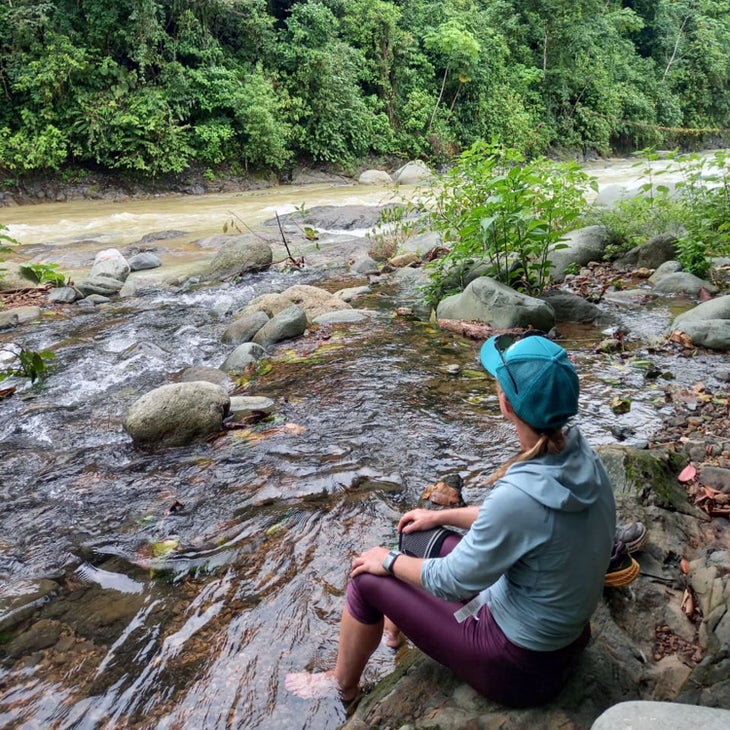
Jen Murphy has visited Costa Rica more than 20 times and feels like she has still barely scratched the surface of all the country offers. Last year she trekked the Camino de Costa Rica from the Caribbean to the Pacific Coast and encountered fewer than five other tourists on the trail.





